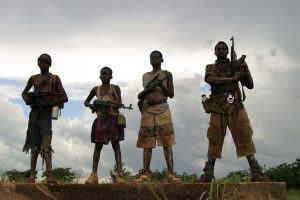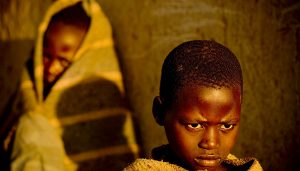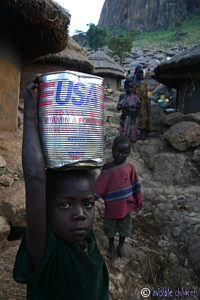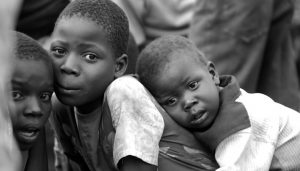On March 21, 2003 – the same day that the war in Iraq started – three young Americans set out on a trip to Africa. They didn’t know it at the time, but this trip would be the start of a social and peaceful Pan-American movement, founded by them. With a camera in hand and eager to ‘tell stories’, these amateur filmmakers arrived ‘by chance’ in northern Uganda. Their discovery of the ‘night commuters’ and of a war fought by children led them to form Invisible Children, an organization with international reach which helps the ‘invisible’ children of Uganda – children who, in order to survive, learn from an early age not to cry.
By: Cristina Ávila-Zesatti / Peace Correspondent
“One child I know says that he gets a headache if he doesn’t see blood… all of them here are damaged: most of them physically, and all of them psychologically…they’re not like children in other parts of the world. Our children aren’t normal.”
A woman talks to the camera, and over her voice the screen shows images of wild child soldiers, or of children brutally torture d to death. The woman is Jolly Okot, who lives in northern Uganda. She’s talking into the lens for three young Americans who’ve turned up in her village almost by chance: three young Americans who, armed with a video camera, would change the history of this region of Uganda.
d to death. The woman is Jolly Okot, who lives in northern Uganda. She’s talking into the lens for three young Americans who’ve turned up in her village almost by chance: three young Americans who, armed with a video camera, would change the history of this region of Uganda.
Bobby Bailey, Laren Poole and Jason Russell are the founders of a peaceful and social movement that started as a group of friends looking for a bit of fun. In search of ‘adventure’ and, in the words of Laren, “to see the real world and not just the one you see on television”, the three students from San Diego decided to travel to Africa. Initially, they were attracted to countries such as Kenya or Sudan which, after all, are exotic places to the average American and tend to receive the greatest media attention: sometimes for their safaris and endless landscapes, and other times for their incomprehensible conflicts – also endless.
In an interview with Peace Correspondent, Laren Poole admitted, “The truth is that the whole thing started out as an adventure…and to begin with we all had different reasons for going on the trip, a trip that changed our hearts, the way we saw the world. So, when we came home we knew that we’d go back…or maybe, now that I think about it, the truth is we never left”. Poole, at the age of 29, has dedicated seven years of his life to a country that he never planned on visiting: Uganda. More specifically, to the region of the Acholi people in northern Uganda. Even more specifically, to one of this region’s biggest problems: a war fought by child soldiers.
They say that nothing happens by chance. Whatever the truth, the journey that Bobby, Jason and Laren set out on started with an omen. Their flight to Africa left on Friday, March 21, 2003 – the very same day that the war in Iraq started.
They didn’t know at that point that theirs would be a journey of peace and that their only weapon – a video camera – would set off a chain reaction leading to a social movement which would rock the conscience of millions of young Americans, and change the destiny of thousands of children from a tribe in northern Uganda.
Invisible children don’t cry. They run away – if they can.
In most cultures, children are scared of the dark and of things that come out at night. But in the Ugandan region of the Acholi, which lies on the border with southern Sudan, these childhood fears are anything but fantasy.
 Quite the opposite – they stem from a terrifying reality. The Acholi children are terrified that while they sleep, the other children will come to their bedsides: the child soldiers that form the Lord’s Resistance Army (LRA), who have been trained to be a real-life nightmare. A deadly nightmare. A nightmare between 7 and 14 years of age, armed with machetes and AK-47s. A nightmare in the form of children with badly fitting uniforms and tiny bodies who come to take other children to a place where they will have to choose between ‘kill’ or ‘be killed’, between ‘torture’ or ‘be tortured’. A nightmare that has been repeating and recreating itself for 23 years; a nightmare that has stolen the dream of childhood from thousands of Ugandan children, between roughly 20,000 and 50,000 from, this region.
Quite the opposite – they stem from a terrifying reality. The Acholi children are terrified that while they sleep, the other children will come to their bedsides: the child soldiers that form the Lord’s Resistance Army (LRA), who have been trained to be a real-life nightmare. A deadly nightmare. A nightmare between 7 and 14 years of age, armed with machetes and AK-47s. A nightmare in the form of children with badly fitting uniforms and tiny bodies who come to take other children to a place where they will have to choose between ‘kill’ or ‘be killed’, between ‘torture’ or ‘be tortured’. A nightmare that has been repeating and recreating itself for 23 years; a nightmare that has stolen the dream of childhood from thousands of Ugandan children, between roughly 20,000 and 50,000 from, this region.
“Now I’m lucky. I can cry, and feel…but there are thousands of children there who can’t”, says China Keitetsi, a young woman who managed to escape the LRA ranks and who received special treatment in Denmark for many years before she was able to reintegrate into ‘normal life’.
China has written a book about her experiences in the ranks of the army, which is 90% made up of soldiers under 15 years old. She explains that the training given is as brutal as it is effective. The children learn good and fast that they must not feel fear, but bring fear. They are only allowed to play one game with each other: killing. And there is only one punishment for disobedience: death. Nearly always slowly. That’s part of the indoctrination.
This humanitarian tragedy, which seems like a bad dream, is nonetheless a reality for an entire generation in this part of Uganda. Every day when the sun sets, children in uniform come out in search of other children because ‘the Lord’s war against the government’ must go on. They prowl around villages, invading houses and terrorizing or murdering the adults and abducting the children.
And this child nightmare is a never-ending vicious cycle for everyone. The abductors don’t want to do it and the abducted don’t want to join the army, but everyone here – both soldiers and civilians – is scared. Everybody must obey if they want to stay alive. And here, more than any other thing, crying – that most human of gestures – is forbidden because it is an external display of fear. Nobody cries: it would be useless.
The Acholi children learn from an early age that crying serves no purpose, except to die sooner at the hands of those who could have been playmates, and who are almost as terrified as they are.
Nocturnal sanctuaries of peace. A story to tell, and to change.
Official statistics tell us that in only a few years, the LRA has abducted and recruited into its ranks around 20,000 children believed to be between 7 and 14 years old. Some international organizations, however, believe that the real figure is much higher and could be as much as 50,000 children. This represents 10% of all child soldiers in the world. The United Nations and the international NGO Save the Children have estimated that there are around 500,000 children serving in the military around the world. 
Uganda, with a population of around 30 million, is ‘a country of children’. Half the population will not live beyond 18 years, and the region known as ‘Acholiland’ is home to around 4% of this precious youth, thousands and thousands of children who have grown up too soon, recruited into the military and turned into soldiers – into child soldiers.
Today, the Acholi population is barely more than a million (1,200,000). The war has cost the lives of more that 130,000 people, and the majority of the current population lives in poverty. There are around 150,000 people from this ethnic group still living in refugee camps close to southern Sudan (although this figure was as high as 2 million) and the district of Gulu has been one of the places worst hit by HIV-AIDS (it is estimate that 6.7% of Uganda’s adult population is infected with HIV). The neighboring region of Kitgum has sadly become ‘famous’ internationally for the deadly Ebola outbreak that hit the region in 2003.
That same year, and completely unaware of the reality of the region, three young travelers from a completely different world arrived ‘by chance’ in the region of northern Uganda. Bobby, Jason and Laren arrived from the United States of America. And they had a camera. They arrived from a frustrating journey across Sudan. And more than anything, they were looking for a story to take back to America: a story which, as they say, was different to what people usually see on television in their country.
They met Jolly Okot in a refugee camp. She spoke to them about these ‘blood-sick children’. She took them to Gulu and told them, “You have to see this”. That was when Bobby, Jason and Laren found out about the ‘night commuters’. Hordes of young people and children who every evening run from the nightmare of the child army who come with one order: recruit or kill.
Churches, bus stations, hospitals, busy streets…any half-lit place, or better still, any place that’s protected and locked, is turned into a temporary refuge for some 45,000 children from all around, who travel miles and miles just to ‘spend the night’ and feel secure in the knowledge that, at least for tonight, they might not have to kill or be killed.
In 2003, not one of the three young Americans who had gone to Africa in search of a story was older than 25, and what they saw in Gulu left them in shock…the only thing they could do was film it.
“That night changed our lives forever. We looked at each other and thought ‘this would never happen in America’, and we asked ourselves, ‘Why here? Is it just because it’s Africa?’”, says Laren Poole’s voice-over commentary while the camera shows an astonishing image: a human carpet made up of hundreds of Acholi children huddled together, half-naked and barefoot, sleeping in unbelievably overcrowded conditions. Brought together for the night with one common wish: that, at least during this night, their sleep won’t be invaded by the nightmare of having to become soldiers.
“We found our story”, says the voice of Laren in the documentary Invisible Children, filmed by three students – amateurs without any previous experience–. Today, the documentary has been seen by millions of people in 200 cities across the world. It became the foundation stone of a major social movement in the USA and marked the beginning of an NGO that has changed the lives of thousands of children and young people in northern Uganda by making them ‘visible’.
A humanitarian tragedy to the beat of MTV
Quick-fire images. Energetic music. Clever shots. Comedy and tragedy, joy and drama perfectly mixed. Dynamic dialogue. People who touch the screen. An impeccable script. An hour-long documentary made with one specific audience in mind: young people.
 Speaking in an interview, Laren Poole says, “We wanted to make something that could touch people of our generation: young people with a certain level of education who know about things going on in the world and who would be interested in the situation in Uganda; who could ‘connect’ with this reality…At first, because we had so much material, we thought about uploading videos to the internet, but then we decided on this other format…a way where, as well as being able to show the film, we could also be in touch with who was watching it because, when we got back from Gulu, what we really wanted was for people to mobilize themselves…We wanted to help stop this disaster and get those kids out of that dark night of fear and blood”.
Speaking in an interview, Laren Poole says, “We wanted to make something that could touch people of our generation: young people with a certain level of education who know about things going on in the world and who would be interested in the situation in Uganda; who could ‘connect’ with this reality…At first, because we had so much material, we thought about uploading videos to the internet, but then we decided on this other format…a way where, as well as being able to show the film, we could also be in touch with who was watching it because, when we got back from Gulu, what we really wanted was for people to mobilize themselves…We wanted to help stop this disaster and get those kids out of that dark night of fear and blood”.
In their own way, and covering a great distance, the founders of Invisible Children fought back against the destructive effects of the LRA forces, recruiting another type of army: hundreds of young volunteers who, after seeing the film, signed up to the cause to save the child soldiers of Uganda. They started working for free in various places in the USA and Latin America.
Between 2007 and 2009, Invisible Children managed to raise $4 million to put towards their projects. Most of this money was raised just with the help of groups of volunteers who organized screenings of the documentary in their schools with the aim of helping schools in northern Uganda. Others had set up lobby groups to engage politicians and public figures in the USA so that they would become involved in the fragile peace process currently happening in the Acholi territory.
One person who saw the film, Adam Fink, spent almost two years in Uganda working for Invisible Children. He says, “I truly believe that young people in the US have a different profile from what people normally think about Americans…that we’re not interested or informed about what’s happening in other parts of the world…This is changing, because these days we think more globally, and we have to act that way too. For me, Invisible Children opened my eyes and my heart. It allowed me to not only witness what was happening, but also to get involved with these kids in Uganda”.
Chris Sarette, who is still barely 25 years old and is a member of the fund-raising team of the organization, agrees: “Since I started working for Invisible Children, I’ve become convinced that another world is possible. The US has its war against terror, but there are other wars going on in the world and it’s time we got involved, that young people demand that the politicians take notice and take action”.
Five years after its first screening in 2005, the documentary Invisible Children is still on tour (the next phase is scheduled for May 2010), although, fortunately for everyone, the central story of the original film has changed radically. Today about thirty young people – all under 30 – officially work for the organization, which has now gone global.
Meanwhile, in northern Uganda, a team of about 100 people manage the projects implemented by this NGO. These include grants for children and young people, micro-economic programs where products are manufactured to benefit the community, dormitories for children, and libraries with books donated by people from all over the world.
Laren says that “when we got back from Uganda, really for me, everything had changed, and I promised myself that I wouldn’t stop until things changed for those kids. We made a film not about a tragedy – although it is – but about human beings who could have been born in any part of the world. We wanted our audience to be sickened by the situation that they were living through, and not by them or by the places, where there’s also a huge amount of joy, strength and hope. Our work there still hasn’t finished”. Laren’s commitment and passion show someone else who has grown up quickly, after all, he was born in the USA around the same time as the war in the Acholi territory was starting.
“Maybe they’ll forget about us when they go back to America, but at least they have the video, to remember us” says a young child from Gulu at the end of the film, staring into the camera of Bobby, Jason and Laren, founders of this movement that brought visibility to the tragedy and also to the enormous resilience of the child soldiers.
Maybe nothing happens by chance and it was these children’s story that found them. Maybe a camera put to good use can be more powerful than violence. And maybe, for once, the bombardment of positive images can put an end to the nightmares of war so that the children of Uganda can return to the dream of a peaceful life.
A holy war that turns children into demonsThe Lord’s Resistance Army (LRS) is led by Joseph Kony, an insurgent who has proclaimed himself ‘sent by God’ to overthrow the Government of Uganda. He claims to be the cousin of the deceased spiritual leader and guerrilla fighter Alice Lakwena, who also said she was ‘possessed’ by a spirit that had told her to fight against the Government.
Before going into combat, the abducted children are subjected to ‘initiation rituals’: they are made to believe that their bodies will be immune to bullets if they are smeared in oil and that the stones they throw will be as powerful as real grenades. Anyone who escapes the ranks and is found must be literally hacked to pieces by the troop. The scars of more ‘compassionate’ punishments are visible on many children and men in northern Uganda: they’ve had their lips and ears cut off – the mark of the LRA. On July 8, 2005, the International Criminal Court issued a warrant for the arrest of Joseph Kony. There are at least 33 charges against him for crimes against humanity and war crimes. In 2006, the LRA was weakened considerably and agreed to negotiate peace with the current Ugandan Government, headed by Yoweri Kaguta Museveni who has been president of the country since 1986, and who could be re-elected in 2011. |
The humanitarian crisis behind the camerasThe situation in northern Uganda continued for years out of sight of the international community and of the mainstream media. For almost a quarter of a century this ‘war fought by children’ spewed out numbers more blood-curdling than those produced at the height of the Iraq war. According to the organizations Save the Children, Amnesty International and Oxfam International, the situation in Uganda is only one of many horrors that escape the cameras.
|
| Child soldiers around the world – will the story continue?
In February 2002 an international protocol came into force prohibiting the use of minors in armed conflicts. At the time of writing, the protocol had been signed and ratified by 86 countries. However, organizations working in this area say that there are still around 50 countries that continue to recruit – both legally and illegally – girls and boys under the age of 18 to fight or to participate in some other way in military activities both on and off the battlefield. It has been calculated that there are at present around 500,000 children operating in the military, many of whom have never known a different way of life. In some conflicts that have ended, demobilization of these children has started (arms amnesties and reintegration into normal life). In terms of the number of child soldiers who have been demobilized, the global figure stands at around 300,000. However, behind this there is an unknown number of children who were born and brought up in captivity and as the possession of the armies, and who have no identification documentation. Whatever the number, the damage done to the majority of these children can be repaired with appropriate treatment given in an atmosphere which is peaceful and constructive.
|
COUNTRIES THAT RECRUIT, OR HAVE RECRUITED, CHILD SOLDIERS
Afghanistan
Angola
Burma
Burundi
Cambodia
Chechenya
Colombia
Democratic Republic of Congo
El Salvador
Guatemala
Guinea Bissau
Honduras
Kosovo
Liberia
Mozambique
Nepal
Northern Ireland
Nicaragua
Philippines
Salvador
Sierra Leone
Somalia
Sudan
Sri Lanka
Uganda


 Lakwena, who called herself ‘the prophet of Uganda’, was the first to create an army made up of children in the early 1980s: the Holy Spirit Mobile Forces (HSMF). The tactics of her terrible successor, Joseph Kony, are much more extreme, mixing the syncretism of local beliefs with a fanatical catholicism. His ultimate goal is to ‘re-found’ a society based on his own interpretation of the ten commandments.
Lakwena, who called herself ‘the prophet of Uganda’, was the first to create an army made up of children in the early 1980s: the Holy Spirit Mobile Forces (HSMF). The tactics of her terrible successor, Joseph Kony, are much more extreme, mixing the syncretism of local beliefs with a fanatical catholicism. His ultimate goal is to ‘re-found’ a society based on his own interpretation of the ten commandments.